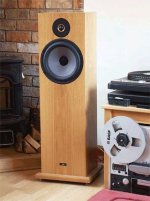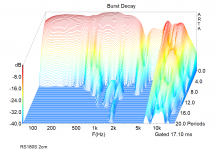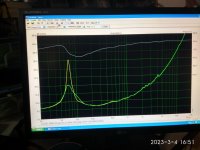I have had my Comeau designed WD25TEx for years and"just for a change" I decided to carry out a suggested modification, namely : : To "skeletise" a bit more, the 19mm mdf main brace which is not only pretty close to the Seas AR26SE4 mid bass driver but also parallel to it so , it "seemed like a good idea" as perhaps the reverse wave rebounding off the solid parts of the brace might be adversely affecting the paper cone, linearity and detail.
So, I have drilled out 2 more 63mm holes on either side of the existing one which receives and helps fix the driver magnet in place and am pleased with the immediate effect seeming to extend output at either extreme, revealing more detail. Jazz trios sound much. much better and classical orchestras seem to have more individual strands but at the price that voices have hardened a bit.
At the same time, I must admit that my speakers were never "ideally" stuffed. Living abroad it was a question of using the materials at hand, namely thick carpet felt and Monacor polyester "dacron" stuff. I suspect I used too much of the latter and therefore would be grateful for a couple of guidelines on how best to go about it. The boxes themselves are made of 19mm particle board dressed outside with 5mm mdf to allow a uniform surface forspraying. I think that with 3 braces, Arboseal sealant all over the place and thickish carpet felt they are pretty well damped and sealed. I am wondering if by changing the dacron for something more suitable, I might ameliorate the slight hardness I am now hearing without needing to open the crossover can of worms. although Peter himself suggests playing with the 2R2 resistor in series with the 0.42mH inductor for added warmth.
The final complication is that the box itself is divided into 2 compartments which communicate via an aperiodic vent consisting of 3 lozenge shaped holes which originally used specifici foam (80 ppsi) as a suitable filter - mine has crumbled to dust - no idea why so I use some thin fibre glass wadding which seems to work well.
Is it a question of just "suck it and see" or are there any rough guidelines for sealed boxes and/or aperiodic ports ?
So, I have drilled out 2 more 63mm holes on either side of the existing one which receives and helps fix the driver magnet in place and am pleased with the immediate effect seeming to extend output at either extreme, revealing more detail. Jazz trios sound much. much better and classical orchestras seem to have more individual strands but at the price that voices have hardened a bit.
At the same time, I must admit that my speakers were never "ideally" stuffed. Living abroad it was a question of using the materials at hand, namely thick carpet felt and Monacor polyester "dacron" stuff. I suspect I used too much of the latter and therefore would be grateful for a couple of guidelines on how best to go about it. The boxes themselves are made of 19mm particle board dressed outside with 5mm mdf to allow a uniform surface forspraying. I think that with 3 braces, Arboseal sealant all over the place and thickish carpet felt they are pretty well damped and sealed. I am wondering if by changing the dacron for something more suitable, I might ameliorate the slight hardness I am now hearing without needing to open the crossover can of worms. although Peter himself suggests playing with the 2R2 resistor in series with the 0.42mH inductor for added warmth.
The final complication is that the box itself is divided into 2 compartments which communicate via an aperiodic vent consisting of 3 lozenge shaped holes which originally used specifici foam (80 ppsi) as a suitable filter - mine has crumbled to dust - no idea why so I use some thin fibre glass wadding which seems to work well.
Is it a question of just "suck it and see" or are there any rough guidelines for sealed boxes and/or aperiodic ports ?
My summary on stuffing: Use natural fibers with huge microscopic surface area (cuz thermodynamics) like raw wool or cotton fluffed up (not felted) and located in the center of the box and not on the walls.
But I also have a friend who uses lots of open celled foam sheets stuck to the walls and auditioned by shouting into the cabinet through the mounting hole, and that works great as well.
But I also have a friend who uses lots of open celled foam sheets stuck to the walls and auditioned by shouting into the cabinet through the mounting hole, and that works great as well.
For those unfamiliar with the World Design 25T EX, I attach an image.
Peter Comeau said "The key to keeping the bass tightly controlled and free of resonant booming is to let the aperiodic vent decide the damping and use just enough fibre filling in each chamber to absorb internal reflections."
The aperiodic foam loading should be adjusted to reduce the bass resonance peak as much as possible.
Peter Comeau said "The key to keeping the bass tightly controlled and free of resonant booming is to let the aperiodic vent decide the damping and use just enough fibre filling in each chamber to absorb internal reflections."
The aperiodic foam loading should be adjusted to reduce the bass resonance peak as much as possible.
Attachments
Apparently the only difference between the pioneer's 'critically' damped reflex was the degree of impedance peak attenuation in that they recommended damping one of each parallel wall, so typically one side top, back and critically damp the vent:Peter Comeau said "The key to keeping the bass tightly controlled and free of resonant booming is to let the aperiodic vent decide the damping and use just enough fibre filling in each chamber to absorb internal reflections."
The aperiodic foam loading should be adjusted to reduce the bass resonance peak as much as possible.
Click Test with 'stretched' as in 'TIGHT AS A DRUM' stretched:
The way that Dynaco adjusted the critical density of the aperiodic vent membrane was "by observing the back EMF of a 5 Hz square wave which has been fed into the speaker system. Damping material is added and compressed until an optimum square wave is shown on an oscilloscope."
Filling of loudspeakers does not only (actually less) address the primary resonance, but more the cavity resonances of the sound reflected on the interior walls of the enclosure.
this is an interesting topic and a complicated one, done wrongly and it can easily be heard. i have started to change my mind about the amount of damping material to use, i think now it do sounds better with too little damping then too much. it is also tricky to simulate before hand.
As the designer stated, there should be just enough fibre filling in each of the two chambers to absorb internal reflections.
It is the density of the material incorporated in the resistive vent connecting the upper chamber to the lower chamber which can be adjusted to achieve the required degree of damping of the bass resonance.
It is the density of the material incorporated in the resistive vent connecting the upper chamber to the lower chamber which can be adjusted to achieve the required degree of damping of the bass resonance.
this is an interesting topic and a complicated one, done wrongly and it can easily be heard. i have started to change my mind about the amount of damping material to use, i think now it do sounds better with too little damping then too much. it is also tricky to simulate before hand.
It's also where you put the material in the enclosure and how much or little the driver reacts to it.
Some drivers (their suspensions) don't seem to care much about how and where you put your material, while others do (a lot).
I've suggested to Dave that he add the suggested value of Res to use when the amplifier damping is unknown, e.g., 0.5 ohm.


Last edited by a moderator:
Can someone explain me,when I use Arta limp for woofer in cabinet impedance measurement.(for ideal damping finding).
First,woofer only,no crossover what is the gol,what I need to look for?
Second,woofer+ crossover,what I need to look for?
Do we looking for the min impedance, adding more damping material?
Thanks in advance,,🤗
First,woofer only,no crossover what is the gol,what I need to look for?
Second,woofer+ crossover,what I need to look for?
Do we looking for the min impedance, adding more damping material?
Thanks in advance,,🤗
I'd say: measure impedance open air and make note of all irregularities (spikes). Then mount the unit, measure again. You'll probably notice some irregularities now. These most likely stem from resonances inside the enclosure. Add damping till they are gone.
Btw, I use ARTA, close miking and burst decay to evaluate the effect of damping. That shows bespoke resonances a lot better.
Btw, I use ARTA, close miking and burst decay to evaluate the effect of damping. That shows bespoke resonances a lot better.
Attachments
Thank you.
As I don't understand your measurement,can you please have a look at this.
Two measurements are from the same woofer in the same box but different damping (green is more damping material inside the box).What is preferable,green or yellow trace?
As I don't understand your measurement,can you please have a look at this.
Two measurements are from the same woofer in the same box but different damping (green is more damping material inside the box).What is preferable,green or yellow trace?
Attachments
What stepped sine setting did you use? Resolution should be as high as possible.
As there are no strong resonances visible I am inclined to think the yellow stuffing is reaonably ok.
As there are no strong resonances visible I am inclined to think the yellow stuffing is reaonably ok.
I've suggested to Dave that he add the suggested value of Res to use when the amplifier damping is unknown, e.g., 0.5 ohm.
First i’ve seen the suggestion, done.
dave
Hi,Thank you.
As I don't understand your measurement,can you please have a look at this.
Two measurements are from the same woofer in the same box but different damping (green is more damping material inside the box).What is preferable,green or yellow trace?
similar thing was on another thread quite recently, see this https://www.diyaudio.com/community/threads/efficient-2-way.380822/post-7282437 and fluids posts in response. There is more in that thread on stuffing and impedance plots, if scan it through.
- Home
- Loudspeakers
- Multi-Way
- How should my speakers be stuffed


